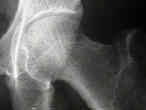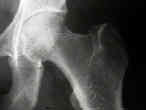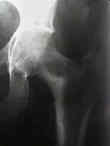- See: Osteoporosis and Hip Fractures


- Bony Trabeculae of the Proximal Femur:
- Ward's Triangle
- Greater Trochanteric Group
- Secondary Compressive Group
- Secondary Tensile Group
- Principal Tensile Group
- Principal Compressive Group
Changes in trabecular pattern of the upper end of the femur as an index of osteoporosis.
- Grade VI:
- all normal trabecular groups are visible
- upper end of femur seems to be completely occupied by cancellous bone;
- Grade V:
- principal tensile & principal compressive trabeculae is accentuated;
- Ward's triangle appears prominent;
- Grade IV:
- principal tensile trabeculae are markedly reduced but can still be traced from lateral cortex to upper part of the femoral neck;
- ref: The influence of osteoporosis in femoral fracture healing time
- Grade III:
- there is a break in the continuity of the principal tensile trabeculae opposite the greater trochanter;
- this grade indicates definite osteoporosis;
- Grade II:
- only principal compressive trabeculae stand out prominently;
- remaining trabeculae have been essentially absorbed;
- Grade I:
- principal compressive trabeculae are markedly reduced in number and are no longer prominent
[Determination of strength of femoral neck in patients with hip fracture]
Evaluation of Singh index for assessment of osteoporosis using digital radiography
Fractures of the proximal femur: correlates of radiological evidence of osteoporosis
Evaluation of the Singh index for measuring osteoporosis
The Singh Index does not correlate with bone mineral density (BMD) measured with dual energy X-ray absorptiometry (DXA) or peripheral quantitative computed tomography (pQCT)


